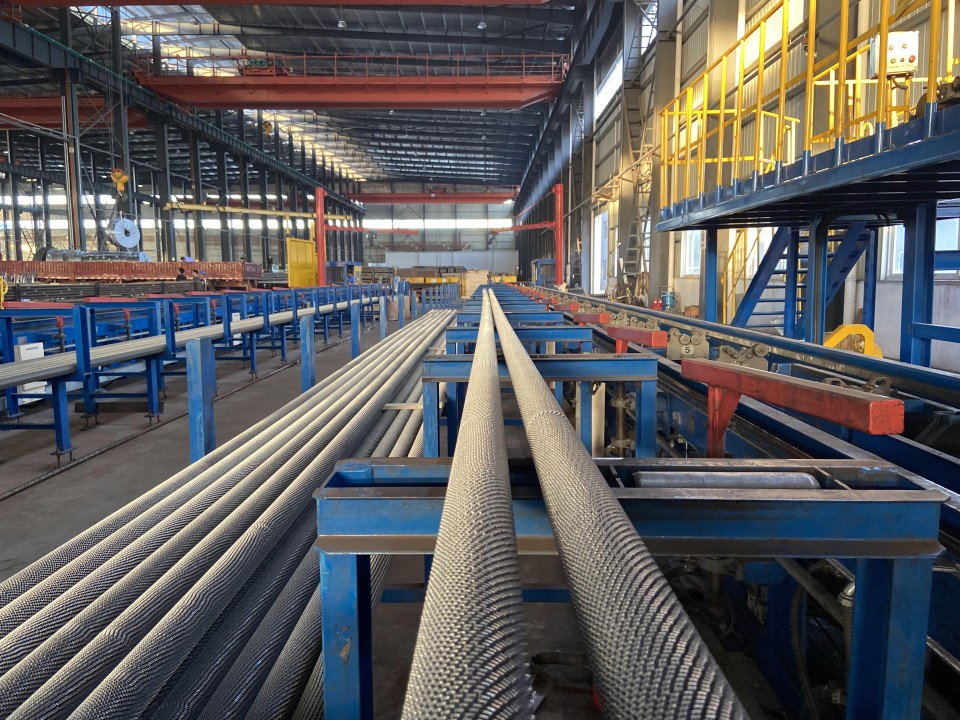Lord Fin Tube--Why boiler use finned tubes
Why Boiler Use Finned Tubes?
In thermal power equipment, finned tubes are engineered to maximize heat transfer efficiency by significantly expanding the heat exchange surface area. The fundamental principle driving their use lies in the substantial disparity between heat transfer coefficients: water or steam inside the tube exhibits a heat transfer coefficient dozens to hundreds of times greater than air or flue gas outside the tube. The finned tube creates a thermal bottleneck on the gas side, which finned tubes effectively address by adding extended surfaces that dramatically increase the initial heat transfer area.
Heat Transfer Performance
Standard boiler configurations demonstrate that finned tubes can enhance heat transfer efficiency by 2-5 times compared to plain tubes, with typical surface area increases ranging from 200% to 800% depending on fin geometry and density.
Technical of Boiler Finned Tubes
| Parameter | Standard Range | Optimal Value | Impact on Performance |
|---|---|---|---|
| Fin Height | 6-25 mm | 12-16 mm | Higher fins increase surface area but may reduce structural integrity |
| Fin Thickness | 0.8-2.0 mm | 1.2-1.5 mm | Thicker fins improve durability but reduce fin efficiency |
| Fin Density | 200-500 fins/meter | 275-400 fins/meter | Higher density increases surface area but may cause fouling |
| Base Tube Diameter | 25-76 mm | 38-50 mm | Larger diameters accommodate higher pressure but reduce compactness |
| Material Compatibility | Carbon Steel, Stainless Steel, Alloys | SA-210, SA-213 T11/T22 | Material selection affects temperature resistance and corrosion properties |
| Temperature Range | Up to 650°C | 450-550°C | Higher temperatures require specialized materials and designs |
Finned Tube Types
Integral Finned Tubes
Manufactured by extruding fins from the base tube material, providing excellent thermal continuity and mechanical strength. Ideal for high-temperature applications up to 650°C with minimal thermal resistance at the fin-base interface.
Bimetallic Finned Tubes
Comprising a base tube (typically carbon steel) with aluminum or copper fins, combining structural strength with superior fin efficiency. The most common type for industrial boilers with operating temperatures below 400°C.
Welded Finned Tubes
Fins are welded to the base tube using specialized processes, offering strong mechanical bonds suitable for high-vibration environments and aggressive operating conditions.
Helical Finned Tubes
Features continuous fins wrapped in a spiral pattern around the tube, providing excellent turbulence and heat transfer characteristics for gas-side applications.
Finned Tubes vs Plain Tubes Comparison
Finned Tube Advantages
- Significantly higher heat transfer efficiency
- Reduced equipment size and weight
- Lower material costs for equivalent performance
- Improved temperature control and regulation
- Enhanced fuel efficiency and operational economy
- Better space utilization in boiler design
Application Considerations
- Higher initial manufacturing complexity
- Potential for fouling in high-particulate environments
- Requires careful fin geometry optimization
- Limited effectiveness when both fluids have high heat transfer coefficients
- Higher pressure drop on finned side
- Specialized cleaning requirements
Applications of Finned Tubes in Boiler Systems
1. Asymmetric Heat Transfer Resistance Compensation: When fluids on either side of a heat transfer process exhibit significantly different heat transfer resistances, fins are strategically placed on the side with higher resistance. This application is critical in steam generators, air chillers, and boiler economizers where gas-side resistance dominates.
2. Dual-Side Enhancement: When both sides of the tube have low heat transfer coefficients, fins can be applied to both surfaces. This approach is commonly implemented in air heaters and certain types of recuperators to maximize overall heat transfer efficiency.
3. Selective Application Scenarios: Finned tubes should not replace threaded or corrugated pipes when both sides of the pipe already exhibit high heat transfer coefficients, such as in power plant condensers where alternative enhancement methods prove more effective.
4. Environmental and Durability Benefits: Modern finned tubes offer exceptional anti-corrosion performance through specialized coatings and material selections, contributing to longer service life and reduced environmental impact through improved efficiency.
5. Wear Resistance: The inherent wear resistance of properly manufactured finned tubes ensures extended operational life in abrasive environments, particularly important in biomass and waste-to-energy boiler applications.
6. Ash Accumulation Reduction: Optimized fin spacing and geometry can significantly reduce ash buildup in coal-fired and biomass boilers, maintaining efficiency and reducing maintenance requirements.

Classification by Finned Tubes Construction and Application
Finned tubes are systematically categorized based on their construction methodology and specific application requirements. The primary classifications include:
Air Heat Exchangers: These finned tubes facilitate efficient cooling by transferring heat to surrounding air, commonly used in air-cooled condensers and charge air coolers. The fin geometry is optimized for maximum air-side heat transfer with minimal pressure drop.
Flue Gas Applications: Specially designed finned tubes recover waste heat from combustion gases in economizers and air preheaters. Materials are selected for high-temperature corrosion resistance, often incorporating protective coatings.
Organic Medium Heat Exchangers: In chemical processing and refinery systems, finned tubes efficiently transfer heat between organic mediums and other fluids, with material compatibility being a critical design consideration.
Refrigeration Systems: These applications utilize finned tubes to transfer heat between refrigerants and secondary mediums, with careful attention to fin efficiency and frost formation characteristics in low-temperature operations.
Electrical Component Cooling: Finned tubes dissipate heat from high-power electrical components like transformers and power electronics, ensuring operational stability and preventing thermal degradation.

